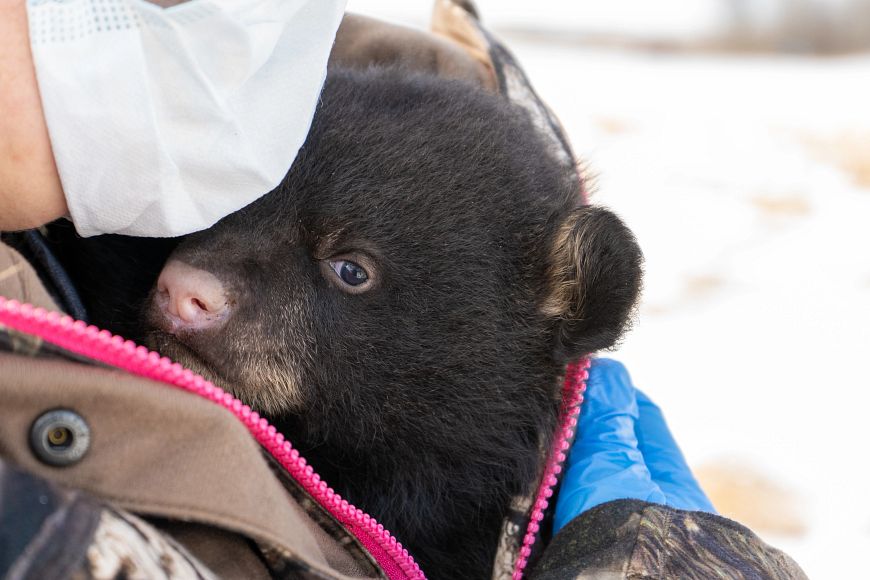Contact: Dr. Jennifer Price Tack, DNR Large Carnivore and Elk Research Scientist
Jennifer.PriceTack@wisconsin.gov or 715-499-1097
DNR Asks Public To Report Black Bear Dens This Winter
 Cubs cannot yet regulate their temperature and have delicate immune systems, so researchers wear protective gear and keep them warm while staff members fit a GPS collar on the mother bear during den surveys.
Photo credit: Wisconsin DNR
Cubs cannot yet regulate their temperature and have delicate immune systems, so researchers wear protective gear and keep them warm while staff members fit a GPS collar on the mother bear during den surveys.
Photo credit: Wisconsin DNR
MADISON, Wis. – The Wisconsin Department of Natural Resources (DNR) encourages the public to report any black bear den locations across Wisconsin to help with an ongoing black bear reproduction study.
While reporting all den locations is critical to the success of this study, there is a particular need for reports in Clark, Taylor, Wood, St. Croix, Pierce, Buffalo and Oneida counties.
The Black Bear Litter and Diet Survey, now entering its third year of data collection, will generate updated estimates of black bear reproductive rates within each of the state’s bear management zones. These updates will improve the accuracy of the population models used to manage black bears. Additionally, researchers are investigating a connection between the consumption of human food and bear reproduction since diet can affect cub survival rates and litter sizes.
Dens tend to get noisier once cubs are born, making locating and reporting them easier in the winter. Many people discover dens by listening for quiet squeaking, grunting, humming or sucking sounds while in the woods.
“Public reporting is essential to this project,” said Dr. Jennifer Price Tack, DNR Large Carnivore and Elk Research Scientist. "Reporting dens helps us meet the sample size requirements for our study and increases the accuracy of the black bear population model."
The public is encouraged to report as much information about occupied black bear dens as possible without approaching or disturbing the dens. Helpful information to report to the bear research team includes:
- GPS coordinates of the den
- A photo of the den, ideally showing it relative to its surroundings, from a safe distance (approximately 30 yards)
- Description of the site and surrounding area, including landmarks
- Any information on the bear(s) and bear activity near the site
After reports are filed, Price Tack and her team will work with den reporters and landowners to visit the sites and determine if the dens are safe, accessible and active before deciding to survey. The research team may be unable to visit every reported den location this season. Dens that are currently occupied will be prioritized.
What Data Will Be Collected
As part of each survey, DNR staff will collect biological data from these dens, including sex, weight and body measurements. Mother bears, known as sows, will be outfitted with GPS collars. These collars help staff learn more about bear foraging behavior and locate the sows in the following years. Revisiting the sows will help DNR staff determine the reproductive success of each sow, such as her litter frequency, litter size and the survival rates of her cubs. Data on sow weight, body measurements and age are also collected.
Bear health and safety are a top priority during surveys. Designated staff monitor the sow’s breathing and heart rate while the rest of the team gathers the needed samples and measurements as quickly as possible. Any cubs present at the den are carefully weighed and sexed. Cubs are tucked into staff’s coats to keep them warm because the cubs cannot yet regulate their temperature. Once researchers are finished collecting samples and fitting collars, the sow and cubs are returned to their den.
Looking Ahead
The Black Bear Litter and Diet Survey team will continue to survey dens for the next 6 to 7 years. Over that time, the team hopes to place tracking collars on at least 100 sows across the state’s bear management zones, with approximately 20 collars per zone.
The team is on pace to achieve its sample-size target but will need new reports each year to meet its benchmark.
To report a known black bear den, visit the DNR's black bear den submission form.

